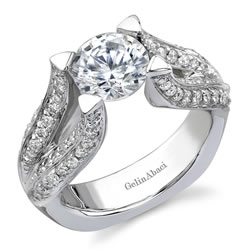We fancy ourselves educators at Joseph Schubach Jewelers. Every week, we instill upon you yet another history lesson connected to the wide world of jewelry.
Of course, we don’t quiz you at the end (though we might – you never know) but we hope you’ll become more informed buyers of moissanite, Gemesis, diamonds, gold, platinum and all the other special gems and metals we have to offer.
Today, a very interesting history of the engagement ring, thanks to the people at Ancient Jewelry Facts.
Since at least 5000 BC, men and women have worn rings – on their thumbs, fingers and even toes.
Some rings have been purely decorative, seal rings and archers’ rings have had useful purposes, while a few have been thoroughly nasty specimens, harboring poison that turned a handshake into a deadly clasp.
The earliest written reference to rings as love tokens is in the second century BC, in works by the Roman playwright Plautus.
The practice of exchanging wedding rings, apparently common in Rome, was “Christianized” by the 4th century AD.An early example of an engagement ring featuring Eros, the ancient symbol of love.
By the 14th century, wealthy Europeans had their wedding rings set with precious jewels, somewhat like modern engagement rings, but it was not until 1477 that the diamond engagement ring as we know it came into being.
That year, the Hapsburg Emperor Maximilian I gave a diamond engagement ring to his fiancée, Mary of Burgundy. This first instance of a royal engagement ring fueled the European passion for diamonds, already aflame by the taste for fine jewels promoted by Mary’s father, Charles the Bold (1433–77).
As the dukes of Burgundy controlled Europe’s major diamond–cutting centers in Antwerp and Bruges, Charles’ encouragement of wealthy Europeans to buy diamonds appears to have a commercial side.
By the 16th century, it seemed no royal marriage was complete without a diamond ring. Mary, Queen of Scots, chose one when she married Lord Darnley in 1565 and in 1673, James II of England sent a diamond ring to Mary of Modena for their proxy wedding in 1673.
In 1839, Prince Albert gave Queen Victoria a diamond ring as a memento of their first meeting, perhaps inadvertently setting the royal seal of approval on diamond engagement rings.
It was during the second half of the 19th century that the practice of giving two rings for the bride became firmly established.
Prince Philip carried on the royal diamond tradition when he gave his fiancée, now Queen Elizabeth II, an engagement ring made with diamonds from the tiara of his mother, Princess Alice.
Norwegian Crown Prince Haakon gave his fiancée a diamond engagement ring that he said was the same one his father gave his mother, and his grandfather King Olav gave to Queen Martha.
Not every royal lady has had diamonds in her engagement ring. The Queen Mother’s ring was sapphire and diamonds, as was Princess Anne’s. Lady Diana Spencer was given a £42,000 sapphire and diamond engagement ring by Prince Charles, while Sarah Ferguson received a ruby and diamond engagement ring from Prince Andrew.
However, Sophie Rhys–Jones took the more traditional line with a three-diamond ring when she became engaged to Prince Edward.
But for size, nothing comes close to the engagement ring Prince Rainier of Monaco gave Grace Kelly. She wore the 12ct diamond ring in her last movie, “High Society”, in 1956. In the film, Bing Crosby looks at the ring and quips, “Some stone, did you mine it yourself?”

